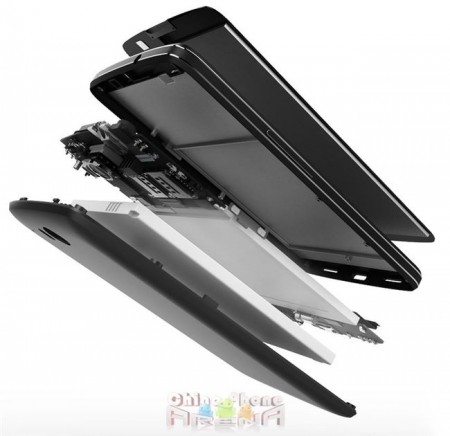Full review now finished. Click here to go to full Innos D6000 review.
It’s not thin at just under 12mm, it’s not light at 188 grams, and it’s not super-powered SoC wise, but beyond being priced right, it’s got a ton of special tacked on.

In keeping Gizbeat PG rated, I won’t be using some of the words I’d like in this preview. Suffice to say, put your Samsung, HTC and Sony up on Craig’s list, toss your iPhone in a lake and post on YouTube your Elephone being ground up in a blender. Here’s the Innos D6000, set to smack your current mobile into the junk drawer.
Innos D6000 review SoC
The SoC in the Innos D6000 is Qualcomm Snapdragon 615 (aka MSM8939). This SoC, in regards to power is generally considered a mid-range SoC, sitting behind the Snapdragon 800 series. Some of the phones that carry this SoC are the Oppo R5, Alcatel Idol 3 and HTC desire 820.
It’s not the most powerful setup, but is beyond powerful enough to run Android and demanding 3D games. To give benchmark geeks an idea of what we’re talking about, think 30,000 Antutu with 6500 3D (1920*1080).

The 615 carries a 64-bit 8-core CPU set in big.LITTLE configuration. That is, 4 Cortex-A53 cores set at 1.5GHz for doing the big-boy stuff: think gaming, CPU intensive apps, heavy websites. And, 4 Cortex-A53 cores set at 1.0GHz for lighter tasks: think chat apps, book reading apps, light web pages and for web pages after they’ve already rendered.
big.LITTLE is an excellent configuration setup to offer both performance in regards to processing power and battery life.
Innos D6000 review RAM / ROM
RAM on the D6000 is a hefty 3GB and is well beyond what’s required to run Android smoothly.
ROM storage is 32GB. Excellent to see Innos step up here and provide 32 as opposed to the standard 16. Assuming SD-storage expandable, 16GB is plenty for power users , but assuming they relegate all storage to one partition, this 32GB can be considered huge and provides an enormous amount of space for installing large games along with hundreds, if not thousands of apps.
In addition to the 32GB, the D6000 supports TF-SD expansion up to 128GB.
Innos D6000 review camera
Things just get better and better with the D6000. The rear camera on the Innos D6000 is outstanding, being the OV16825. This is a true 16MP 1/2.3″ sensor. This sensor size is the same as nearly all consumer compact stand alone cameras. It means sharper images and better low-light performance. Along with the sensor-size is the sensor technology. The OV16825 is 2nd generation BSI (back side illuminated), which further improves low-light capabilities.
From OmniVision:
OmniVision’s OV16820 and OV16825 are 16-megapixel CameraChip™ sensors that support 16-megapixel burst photography and can capture 4K2K or Quad Full High Definition (QFHD) video at 60 frames per second (fps). Built on OmniVision’s high-performance 1.34-micron OmniBSI-2™ pixel architecture
The 1/2.3-inch CameraChip sensors are capable of operating in full resolution (4608×3456) at 30 fps, 4K2K (3840×2160) video at 60 fps, and 1080p HD video at 60 fps with extra pixels for electronic image stabilization (EIS).
Beyond the sensor size and BSI specs, the OV16825 is capable of some impressive stuff; 30fps 16mp video and 60fps 4K video, as well as pixel-binning. Pixel-binning is a method which improves overall image quality and reduces noise (at the cost of decreasing sharpness when viewing huge crops).

The 30fps 16mp video is especially interesting. It means you can take a 1-second video and have 30 full resolution frames (or for example, 5-seconds and have 150 full res frames) to choose as the best shot. Great for important moments when you need to catch something at the perfect moment: think kids playing, pets, sports.
The OV16825 supports manual shooting, which allows the user to adjust aperture, shutter speed, and ISO if they wish.
Also supported is digital image stabilization, which means those little hand movements and slight shaking which cause blurry images can be significantly reduced.
Keep in mind, these are the capabilities of the camera sensor, it doesn’t necessarily mean the Innos D6000 will carry the software to support all of these features. Time will tell. At the very least, the true 16mp, BSI-2, 1/2.3″ sensor will provide significant improvements over the typical 13mp 1/3.2″ sensor in many China mobiles and flagship brand mobiles.
Innos D6000 review battery
Beyond all that I’ve mentioned prior, the big news here is the enormous battery, or batteries I should say. The Innos D6000 includes an already adequate internal 2480mAh battery, along with a huge external 3520mAh battery, making for a combined meganormous 6000mAh.
At this point there are some questions as to how these batteries will be utilized: will the external battery kick-in after the internal is low, or vice versa? Or will they be drew upon equally as one large battery? Or perhaps some other configuration such as alternating between batteries, or having the batteries power different components.

Whatever the case, it’s a huge amount juice and guaranteed to provide even the most heavy users beyond adequate battery life. As an educated guess, the phone should provide 12-15 hours onscreen time with standard use (WiFi, lux 140, 720p video, both SIMs in, surfing, chat, Facebook).
Specs at a glance
- 5.2″@1080P JDI Pixel Eyes™ 423PPI Gorilla Glass 3 protected
- 850/900/1900/2100 worldwide 3G WCDMA UMTS HSPDA
- 1/3/7/8/20/38/39/40/41 4G LTE
- Snapdragon 615 (MSM8939)
- GE Lexan * EXL1414 Polycarbonate (PC) siloxane Copolymer Resin back piece
- 4+4 [email protected] & 1.0GHz
- 3GB RAM (LPDDR3 933MHz)
- Adreno 405 GPU
- Wolfson sound processor
- 32GB ROM storage
- GLONASS GPS support
- OV16825 16MP 1/2.3″ BSI-2 rear camera
- OV5648 5MP 1/4″ OmniBSI+ front camera
Innos [email protected]
It’s been awhile since I’ve been this excited about a new release. The best part? The Innos D6000 is right around the corner with a scheduled release date of August 15th. There’s a presale special going on at Gearbest. First come, first serve. You can bet Gizbeat will be in line.









Leave a Reply